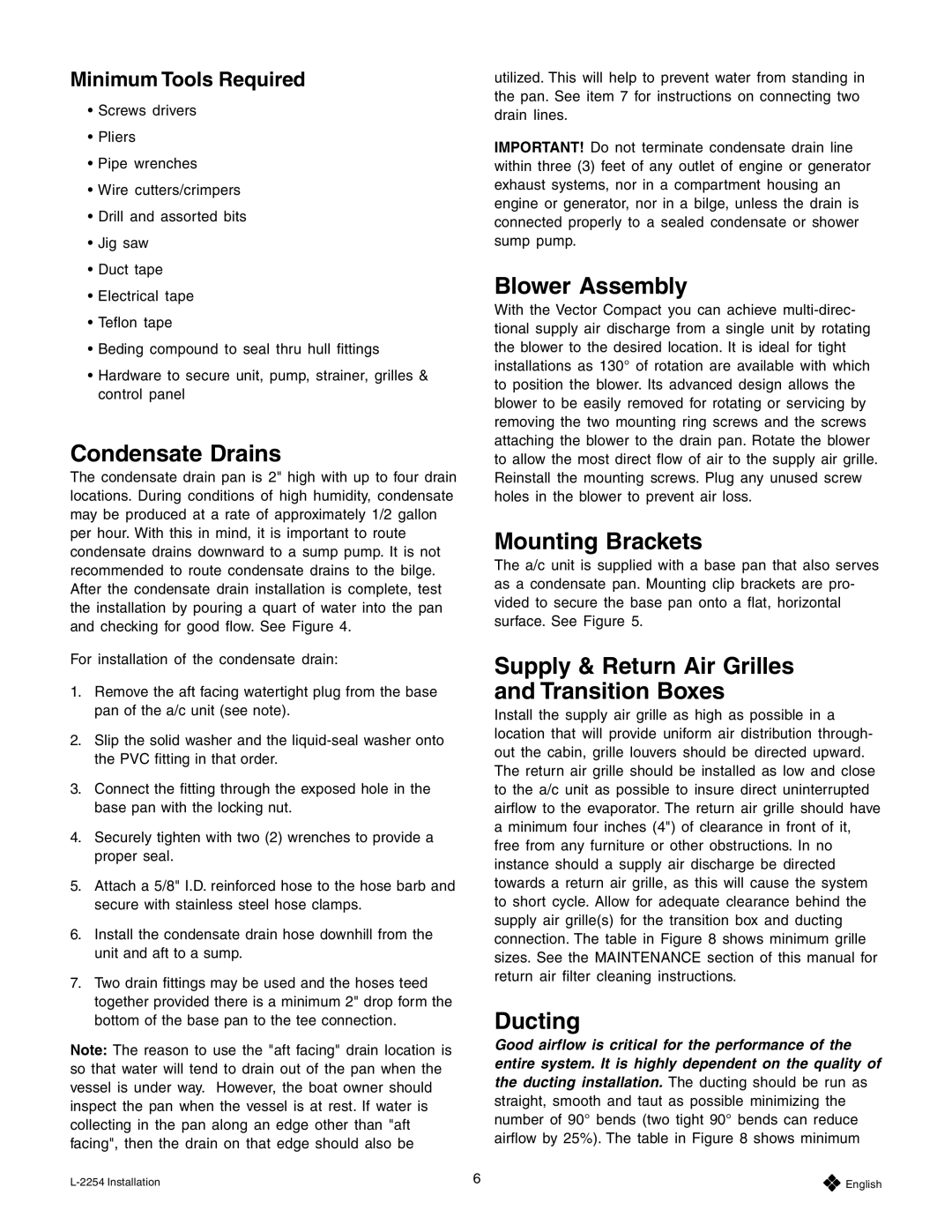Minimum Tools Required
•Screws drivers
•Pliers
•Pipe wrenches
•Wire cutters/crimpers
•Drill and assorted bits
•Jig saw
•Duct tape
•Electrical tape
•Teflon tape
•Beding compound to seal thru hull fittings
•Hardware to secure unit, pump, strainer, grilles & control panel
Condensate Drains
The condensate drain pan is 2" high with up to four drain locations. During conditions of high humidity, condensate may be produced at a rate of approximately 1/2 gallon per hour. With this in mind, it is important to route condensate drains downward to a sump pump. It is not recommended to route condensate drains to the bilge. After the condensate drain installation is complete, test the installation by pouring a quart of water into the pan and checking for good flow. See Figure 4.
For installation of the condensate drain:
1.Remove the aft facing watertight plug from the base pan of the a/c unit (see note).
2.Slip the solid washer and the
3.Connect the fitting through the exposed hole in the base pan with the locking nut.
4.Securely tighten with two (2) wrenches to provide a proper seal.
5.Attach a 5/8" I.D. reinforced hose to the hose barb and secure with stainless steel hose clamps.
6.Install the condensate drain hose downhill from the unit and aft to a sump.
7.Two drain fittings may be used and the hoses teed together provided there is a minimum 2" drop form the bottom of the base pan to the tee connection.
Note: The reason to use the "aft facing" drain location is so that water will tend to drain out of the pan when the vessel is under way. However, the boat owner should inspect the pan when the vessel is at rest. If water is collecting in the pan along an edge other than "aft facing", then the drain on that edge should also be
utilized. This will help to prevent water from standing in the pan. See item 7 for instructions on connecting two drain lines.
IMPORTANT! Do not terminate condensate drain line within three (3) feet of any outlet of engine or generator exhaust systems, nor in a compartment housing an engine or generator, nor in a bilge, unless the drain is connected properly to a sealed condensate or shower sump pump.
Blower Assembly
With the Vector Compact you can achieve
Mounting Brackets
The a/c unit is supplied with a base pan that also serves as a condensate pan. Mounting clip brackets are pro- vided to secure the base pan onto a flat, horizontal surface. See Figure 5.
Supply & Return Air Grilles and Transition Boxes
Install the supply air grille as high as possible in a location that will provide uniform air distribution through- out the cabin, grille louvers should be directed upward. The return air grille should be installed as low and close to the a/c unit as possible to insure direct uninterrupted airflow to the evaporator. The return air grille should have a minimum four inches (4") of clearance in front of it, free from any furniture or other obstructions. In no instance should a supply air discharge be directed towards a return air grille, as this will cause the system to short cycle. Allow for adequate clearance behind the supply air grille(s) for the transition box and ducting connection. The table in Figure 8 shows minimum grille sizes. See the MAINTENANCE section of this manual for return air filter cleaning instructions.
Ducting
Good airflow is critical for the performance of the entire system. It is highly dependent on the quality of the ducting installation. The ducting should be run as straight, smooth and taut as possible minimizing the number of 90° bends (two tight 90° bends can reduce airflow by 25%). The table in Figure 8 shows minimum
6 | ❖ English | |
|
|
